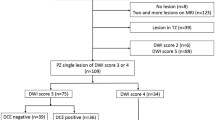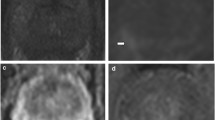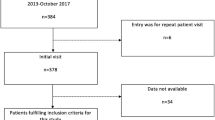Abstract
Purpose
To assess the added value of the dynamic contrast-enhanced sequence (DCE) to combination T2-weighted imaging (T2w) + diffusion-weighted imaging (DWI) in detecting prostate cancer (PCa) recurrence after HIFU (high-intensity focused ultrasound).
Methods
Forty-five males with clinical and biological suspected PCa recurrence were retrospectively selected. All underwent multi-parametric MRI (mpMRI) before biopsies. Two readers independently assigned a Likert score of cancer likelihood on T2w + DWI + DCE and T2w + DWI images. Prostatic biopsies were taken as the gold standard.
Results
Recurrent PCa was identified at biopsy for 37 patients (82%). Areas under the receiver-operating curve of T2w + DWI and T2w + DWI + DCE imaging were not significantly different for both readers. Using a Likert score ≥ 3 for the PCa diagnosis threshold, sensitivity at the lobe level for the (1) senior and (2) junior reader for T2w +DWI +DCE sensitivity was (1) 0.97 and (2) 0.94 vs. (1) 0.94 and (2) 0.97 for T2w + DWI.
Conclusion
Accuracy of mpMRI was not significantly improved by adding DCE to T2w + DWI. Sensitivity was high for T2w + DWI + DCE and T2w + DWI with no significant difference for either the junior or senior reader.
Key Points
• MpMRI has the capability to detect PCa recurrence in post-HIFU monitoring.
• The sensitivity of T2w and DWI for detecting PCa recurrence was not improved by DCE.
• Readers with different degrees of experience did not improve their performance with DCE.



Similar content being viewed by others
Abbreviations
- 3D:
-
3-dimensional
- ADC:
-
Apparent diffusion coefficient
- AS:
-
Anterior fibromuscular stroma
- AUROC:
-
Area under the ROC curve
- CSC:
-
Confidential interval
- CI:
-
Clinically significant cancer
- DCE:
-
Dynamic contrast enhancement sequence
- Dw:
-
Diffusion- weighted imaging
- ERBT:
-
External beam radiation therapy
- HIFU:
-
High-intensity focused ultrasound
- IQR:
-
Interquartile range
- mpMRI:
-
Multiparametric magnetic resonance imaging
- MRI:
-
Magnetic resonance imaging
- PCa:
-
Prostate cancer
- PSA:
-
Prostate-specific antigen
- ROI:
-
Region of interest
- ROC:
-
Receiver-operating characteristic
- Se:
-
Sensitivity
- Sp:
-
Specificity
- STB:
-
Standard biopsy
- T2w:
-
T2-weighted imaging
- TB:
-
Targeted biopsies
- TRUS:
-
Trans-rectal ultrasound
References
Sartor AO, Hricak H, Wheeler TM et al (2008) Evaluating localized prostate cancer and identifying candidates for focal therapy. Urology 72:S12–S24
Valerio M, Ahmed HU, Emberton M et al (2014) The role of focal therapy in the management of localised prostate cancer: a systematic review. Eur Urol 66:732–751
Ganzer R, Fritsche H-M, Brandtner A et al (2013) Fourteen-year oncological and functional outcomes of high-intensity focused ultrasound in localized prostate cancer. BJU Int 112:322–329
Abdel-Wahab M, Pollack A (2010) Prostate cancer: Defining biochemical failure in patients treated with HIFU. Nat Rev Urol 7:186–187
Loeb S, Vellekoop A, Ahmed HU et al (2013) Systematic review of complications of prostate biopsy. Eur Urol 64:876–892
Moore CM, Kasivisvanathan V, Eggener S et al (2013) Standards of reporting for MRI-targeted biopsy studies (START) of the prostate: recommendations from an International Working Group. Eur Urol 64:544–552
Scheltema MJ, Tay KJ, Postema AW et al (2017) Utilization of multiparametric prostate magnetic resonance imaging in clinical practice and focal therapy: report from a Delphi consensus project. World J Urol 35:695–701
Rouvière O, Girouin N, Glas L et al (2010) Prostate cancer transrectal HIFU ablation: detection of local recurrences using T2-weighted and dynamic contrast-enhanced MRI. Eur Radiol 20:48–55
Kim CK, Park BK, Lee HM (2009) Prediction of locally recurrent prostate cancer after radiation therapy: incremental value of 3T diffusion-weighted MRI. J Magn Reson Imaging JMRI 29:391–397
Punwani S, Emberton M, Walkden M et al (2012) Prostatic cancer surveillance following whole-gland high-intensity focused ultrasound: comparison of MRI and prostate-specific antigen for detection of residual or recurrent disease. Br J Radiol 85:720–728
Hoquetis L, Malavaud B, Game X et al (2016) MRI evaluation following partial HIFU therapy for localized prostate cancer: A single-center study. Prog Urol 26:517–523
Rouvière O, Dagonneau T, Cros F et al (2017) Diagnostic value and relative weight of sequence-specific magnetic resonance features in characterizing clinically significant prostate cancers. PLOS ONE 12:e0178901
Ramalho J, Ramalho M, Jay M et al (2016) Gadolinium toxicity and treatment. Magn Reson Imaging 34:1394–1398
Reeder SB, Gulani V (2016) Gadolinium deposition in the brain: Do we know enough to change practice? Radiology 279:323–326
Conte G, Preda L, Cocorocchio E et al (2017) Signal intensity change on unenhanced T1-weighted images in dentate nucleus and globus pallidus after multiple administrations of gadoxetate disodium: an intraindividual comparative study. Eur Radiol. https://doi.org/10.1007/s00330-017-4810-3
D’Amico AV, Moul J, Carroll PR et al (2003) Cancer-specific mortality after surgery or radiation for patients with clinically localized prostate cancer managed during the prostate-specific antigen era. J Clin Oncol 21:2163–2172
de la Rosette J, Ahmed H, Barentsz J et al (2010) Focal therapy in prostate cancer-report from a consensus panel. J Endourol 24:775–780
Rozet F, Bastide C, Beuzeboc P et al (2015) Prise en charge des tumeurs de la prostate à faible risque évolutif. Prog En Urol 25:1–10
Renard-Penna R, Rouprêt M, Comperat E et al (2013) Accuracy of high resolution (1.5 tesla) pelvic phased array magnetic resonance imaging (MRI) in staging prostate cancer in candidates for radical prostatectomy: Results from a prospective study. Urol Oncol 31:448–454
Renard-Penna R, Mozer P, Cornud F et al (2015) Prostate imaging reporting and data system and Likert scoring system: multiparametric MR imaging validation study to screen patients for initial biopsy. Radiology 275:458–468
Ahmed HU (2009) The index lesion and the origin of prostate cancer. N Engl J Med 361:1704–1706
Barentsz JO, Richenberg J, Clements R et al (2012) ESUR prostate MR guidelines 2012. Eur Radiol 22:746–757
Haas M, Günzel K, Miller K et al (2017) Is the ellipsoid formula the new standard for 3-Tesla MRI prostate volume calculation without endorectal coil? Urol Int 98:49–53
Mozer P, Rouprt M, Le Cossec C et al (2015) First round of targeted biopsies using magnetic resonance imaging/ultrasonography fusion compared with conventional transrectal ultrasonography-guided biopsies for the diagnosis of localised prostate cancer: MRI/TRUS-fusion targeted vs standard TRUS-guided biopsy. BJU Int 115:50–57
Billia M, Siddiqui KM, Chan S et al (2016) Assessment of histopathological features of needle biopsy in recurrent prostate cancer following salvage high-intensity focused ultrasound. Can Urol Assoc J J Assoc Urol Can 10:416–422
Valerio M, Donaldson I, Emberton M et al (2015) Detection of Clinically Significant Prostate Cancer Using Magnetic Resonance Imaging-Ultrasound Fusion Targeted Biopsy: A Systematic Review. Eur Urol 68:8–19
Schoots IG, Roobol MJ, Nieboer D et al (2015) Magnetic resonance imaging-targeted biopsy may enhance the diagnostic accuracy of significant prostate cancer detection compared to standard transrectal ultrasound-guided biopsy: a systematic review and meta-analysis. Eur Urol 68:438–450
Donaldson IA, Alonzi R, Barratt D et al (2015) Focal therapy: patients, interventions, and outcomes--a report from a consensus meeting. Eur Urol 67:771–777
Gelet A, Chapelon JY, Bouvier R et al (1996) Treatment of prostate cancer with transrectal focused ultrasound: early clinical experience. Eur Urol 29:174–183
Alonzo F, Melodelima C, Bratan F et al (2016) Detection of locally radio-recurrent prostate cancer at multiparametric MRI: Can dynamic contrast-enhanced imaging be omitted? Diagn Interv Imaging 97:433–441
Schalekamp S, van Ginneken B, Schaefer-Prokop CM, Karssemeijer N (2014) Influence of study design in receiver operating characteristics studies: sequential versus independent reading. J Med Imaging (Bellingham) 1:015501
Rosset R, Bratan F, Crouzet S et al (2017) Can pre- and postoperative magnetic resonance imaging predict recurrence-free survival after whole-gland high-intensity focused ablation for prostate cancer? Eur Radiol 27:1768–1775
Abd-Alazeez M, Ramachandran N, Dikaios N et al (2015) Multiparametric MRI for detection of radiorecurrent prostate cancer: added value of apparent diffusion coefficient maps and dynamic contrast-enhanced images. Prostate Cancer Prostatic Dis 18:128–136
Hausmann D, Aksöz N, von Hardenberg J et al (2017) Prostate cancer detection among readers with different degree of experience using ultra-high b-value diffusion-weighted Imaging: Is a non-contrast protocol sufficient to detect significant cancer? Eur Radiol. https://doi.org/10.1007/s00330-017-5004-8
Donati OF, Jung SI, Vargas HA et al (2013) Multiparametric prostate MR imaging with T2-weighted, diffusion-weighted, and dynamic contrast-enhanced sequences: are all pulse sequences necessary to detect locally recurrent prostate cancer after radiation therapy? Radiology 268:440–450
Kirkham AP, Emberton M, Hoh IM et al (2008) MR Imaging of Prostate after Treatment with High-Intensity Focused Ultrasound 1. Radiology 246:833–844
Vargas HA, Wassberg C, Akin O, Hricak H (2012) MR imaging of treated prostate cancer. Radiology 262:26–42
Rischmann P, Gelet A, Riche B et al (2017) Focal High Intensity Focused Ultrasound of Unilateral Localized Prostate Cancer: A Prospective Multicentric Hemiablation Study of 111 Patients. Eur Urol 71:267–273
Funding
The authors state that this work has not received any funding.
Author information
Authors and Affiliations
Corresponding authors
Ethics declarations
Guarantor
The scientific guarantor of this publication is Raphaele Renard Penna.
Conflict of interest
The authors of this manuscript declare no relationships with any companies, whose products or services may be related to the subject matter of the article.
Statistics and biometry
Alexandre Lafourcade and Lisa Belin (Hopital Pitié Salpétrière) kindly provided statistical advice for this manuscript.
Informed consent
Written informed consent was obtained from all subjects (patients) in this study.
Ethical approval
Institutional Review Board approval was not required because the methodology of the study was retrospective on imaging materials, without any supplementary interventions than routine practice for medical care.
Methodology
• retrospective
• diagnostic or prognostic study
• performed at one institution
Electronic supplementary material
ESM 1
(DOCX 117 kb)
Rights and permissions
About this article
Cite this article
Lotte, R., Lafourcade, A., Mozer, P. et al. Multiparametric MRI for Suspected Recurrent Prostate Cancer after HIFU:Is DCE still needed?. Eur Radiol 28, 3760–3769 (2018). https://doi.org/10.1007/s00330-018-5352-z
Received:
Accepted:
Published:
Issue Date:
DOI: https://doi.org/10.1007/s00330-018-5352-z




